







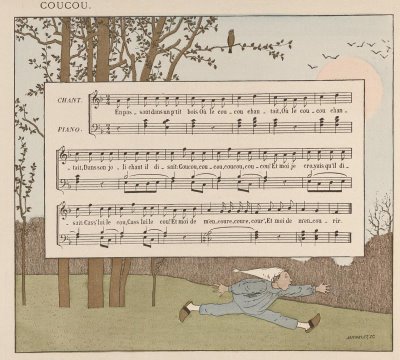


There is no way on earth I would let a child near this beautiful 56 page book: 'Vieilles Chansons et Ronds pour les Petits Enfants' (the book title and the title page are a little different) - a children's songbook by Charles-Marie Widor with just gorgeous illustrations by Maurice Boutet de Monvel.
It is dated sometime between 1910-1920 and is online with high resolution images at the Library of Congress. The printing quality is particularly excellent.
There are 2 other books online illustrated by de Monvel -- 'La Civilité (Puérile et Honnête)' and 'Joan of Arc' -- at childrensbooksonline.

Saturday, June 17, 2006
Vielles Chansons
Dyas Chymica Tripartita II
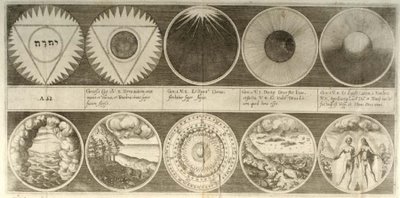







 All of the above amazing engravings comes from the alchemical emblemata work, 'Hermetico-Spagyrisches Lustgärtlein'. Click the images for full sized versions.
All of the above amazing engravings comes from the alchemical emblemata work, 'Hermetico-Spagyrisches Lustgärtlein'. Click the images for full sized versions.
“The one hundred and sixty hermetick emblems [are] attributed to the heroes of alchemy, historical and mythical, famous and anonymous".

The above 'draco' images come from the 'Lambspring book' (an earlier hand painted set) - I think the engravings here are a reissue by the same publisher Lucas Jennis; as the 'Lambspring book' was released in the same year of publication as 'Dyas Chymica Tripartita', 1625: from where these engravings derive.

 I'm afraid I don't remember in which of the 7 works contained in 'Dyas Chymica Tripartita' (compiled by Johann Grasshoff ) these illustrations are found. The full book is online at Herzog August Bibliothek, Wolfenbüttel. Wonderfully obscure.
I'm afraid I don't remember in which of the 7 works contained in 'Dyas Chymica Tripartita' (compiled by Johann Grasshoff ) these illustrations are found. The full book is online at Herzog August Bibliothek, Wolfenbüttel. Wonderfully obscure.
Between this post and the last entry, more than half of the engravings in the 250+ page book have been uploaded. A few of the remaining illustrations contain symbology more obviously occult in nature.
Previously: alchemy, emblemata.
Friday, June 16, 2006
Dyas Chymica Tripartita I














 [click the images for full sized versions]
[click the images for full sized versions]
'Dyas Chymica Tripartita' is an exceedingly rare* book from 1625 compiled by Johann Grasshoff which includes 6 (or 7) philosophical treatises on alchemy.
To the best of my very limited understanding (combined with extensive confusion from reprinting details, translations and general obscurity) the book includes:
-'Liber Alze' (A Very Brief Tract Concerning the Philosophical Stone). Author uknown.
-The 'Aureum Seculum', written by Adrian von Mynsicht under the pseudonym Henricus Madathanus.
-'The Book of Lambspring'.
-'Twelve Keys' by Basilius Valentinus, the Benedictine.
-'Hermetico-Spagyrisches Lustgärtlein Darrinen Hundert and Sechtzig' - a work of 120 emblems defining the true hermetic alchemists in emblematic terms (there are a few examples at the top of this post and more in the following entry).
-I haven't quite worked out the names of the other treatises in 'Dyas Chymica Triparita', which is online in its entirety (no thumbnails unfortunately) at Herzog August Bibliothek, Wolfenbüttel. The majority of headings as well as epigrams for the emblemata are in latin, while the substantive text is in german.
The other images above come from the 'Twelve Keys' series by Basilus Valentinus -- "with which we may open the doors of the knowledge of the Most Ancient Stone and unseal the Most Secret Fountain of Health." The engravings may have been produced by Matthæus Merian.
* "A complete copy of the 'Dyas Chymica' has been listed for as much as £25000"
Fellini Caricatures






These 1937 'caricatura cinematografica' from film director Federico Fellini (1920-1993) are among a collection of 79 images at Bologna's Biblioteca dell'Archiginnasio [put 'fellini' in the search box and click on the image icons at far right on the results page].
The majority are simple pen drawings and many of those are labelled: 'caricatura femminile erotica'. Whimsical and humorous and a little bit mad, as you'd expect. Prior to his film career, Fellini had a 'laughing faces' shop from which he sold sketches to American soldiers.
"I will not loiter in repositories with hugely annoying watermarks.
I will not loiter in repositories with hugely annoying watermarks.
I will not loiter in..." *sigh*
Tuesday, June 13, 2006
Ars Moriendi
Edward Young
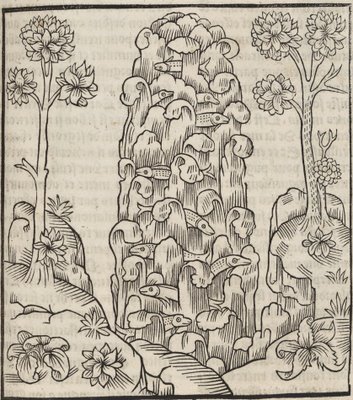
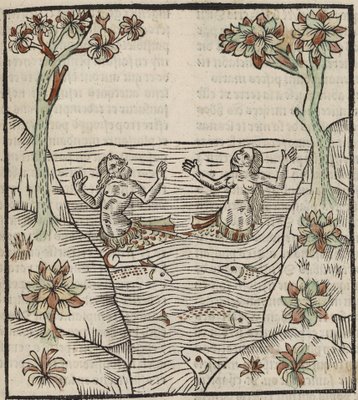
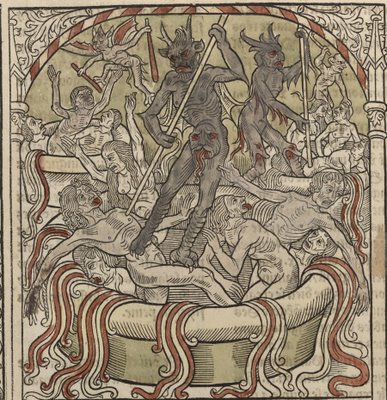
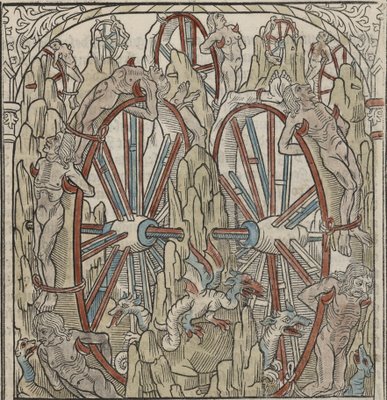

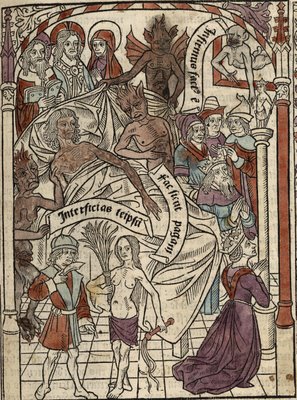



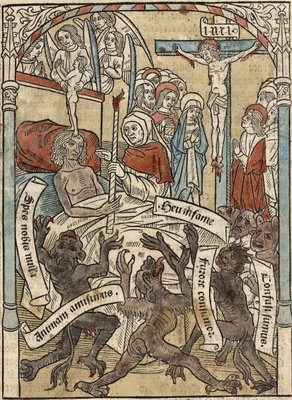
'Ars Moriendi' ('The Art of Dying') refers to two related texts (long and short versions) which emerged in Europe in the early and mid-15th century respectively.
"The first is a longer treatise of six chapters that prescribes rites and prayers to be used at the time of death. The second is a brief, illustrated book that shows the dying person's struggle with temptations before attaining a good death."The book containing 11 illustrations depicts scenes where lack of faith, despair, impatience, spiritual pride, and avarice tempt a dying person. Thus we have the demonic and angelic figures at the bedside above representing the temptations and corresponding redemptions through which the soon to depart must negotiate to obtain salvation. The last image shows the soul as a(n)
With the devastation of the black plague across Europe and the hundred years war between France and England, an early death was a distinct possibility if you were living in the 15th century. While the 'danse macabre' genre was more of an artistic response to the possibility of an early demise, 'Ars Moriendi' formalized emerging religious doctrines associated with the practices related to death, dying and eternity. But it also underlined the need for a person to be ready to die.
Originally published in latin, 'Ars Moriendi' was widely translated and appeared in various forms across Europe. I snagged the above images weeks ago from a 400+ page french version which I presume is actually the longer book combined with more than the original 11 woodcut illustrations. A couple of the above images are definitely 'extras'.
- 'Ars Moriendi' page by page {Rosenwald 424} - 'L'art de Bien Viure et de Bien Mourir, etcet' - at the Library of Congress [title page/printer's mark]
- A quick framed view of another version of the illustrations.
- 'Ars Moriendi' by Douglas F Duclow at deathreference.
- Wikipedia.
- Tangential: 'Social Intercession in Early Modern Gloucestershire' © Kirsty Owen: a scholarly essay reviewing the objects pertaining to the process of dying and the maintenance of a social heirarchy after death. [via]
- Even more tangential: 'The Gashlycrumb Tinies' by Edward Gorey, a 1962 macabre childrens(?) A to Z of death. [via]
- Somewhat tangential: 'Ars Moriendi in Numbers' © Catya Plate: painted canvas artworks.


















